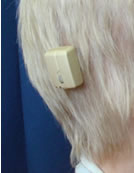Pfeiffer Sydrome: Physical Traits
The Ears:
The external ears are usually normally shaped, but are positioned slightly lower than average. The inner ear may be affected in a number of ways. As a result of the mid facial hypoplasia, the inner ear does not drain well, and children frequently develop otitis media, or ear infections. Most often, infants require placement of small tubes in the ear to prevent frequent infections and chronic scarring of the eardrum. In addition, the bones of the inner ear may be partially fused together, contributing to a “conductive” hearing loss. We have noted among our Pfeiffer patients in Dallas that almost 60% of all children with Pfeiffer syndrome have incompletely formed ear canals (up to 100% in Type III’s). Some children are candidates for BAHA’s (bony conductive hearing aids that are implanted into the skull). We recommend delaying BAHA placement, until children are in their teens, because the presence of BAHA’s can complicate some types of skull surgery that are needed before adolescence. Many adults with Pfeiffer syndrome have some degree of hearing loss, so careful attention to the ears is important in infancy and childhood.
 A BAHA hearing aid. A BAHA hearing aid.
Other Pfeiffer Syndrome Physical Traits:
Skull | Brain | Eyes & Midface | Mouth | Hands
& Feet
<<more about Pfeiffer
Syndrome
|



